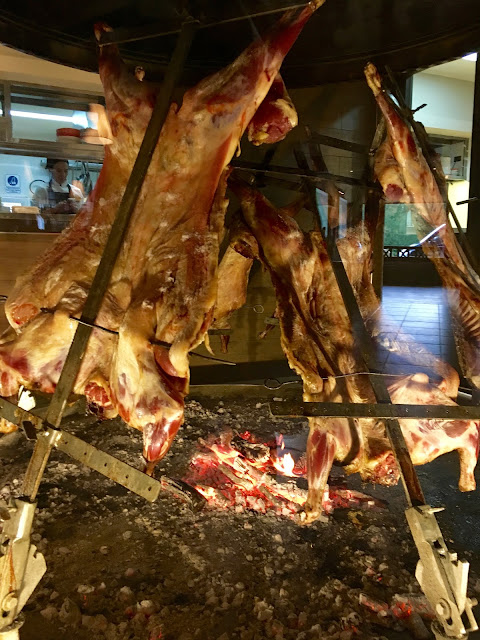We tried Suribi (a type of catfish) and Pacu (a large freshwater fish), both river fishes. Grilled at La Rueda, both were delicious, probably because they were fresh - we must be close to the river! Then as we headed into Patagonia, we tried trout in Bariloche and a most delicious Hake fish at lunch in Puella, in the midst of our Andean Lakes Crossing. It was like a ray of sunshine in our drizzly crossing. The Hake is related to the cod with firm but tender white meat. I like it better than cod but then it could be the way it was cooked.
 |
| Pacu and suribi at La Rueda |

 |
| The Hake in the Puella Hotel restaurant |
When we got to Puerto Varas in Chile, we were pleasantly surprised by the Conger eel. It is not an actual eel, apparently, and certainly did not taste like one. It had a nice white fish consistency and texture. There were always salmon on the menu but with so much salmon at home, we did not want to waste our tasting opportunities on salmon - afterall how different could it taste from one end of the Americas to the other? I did try a small piece off our guides' plate just to confirm my guess. We had the rollizo (rockfish) instead and it was tasty, very well-prepared served on a warm quinoa salad.
 |
| Conger eel in the Mirador del Lago, Puerto Varas, Chile |
 |
| Rollizo in La Jardinera, Puerto Varas, Chile |
The high points of our trip to Ushuaia, other than the penguins, were our encounters with Southern King Crab and Merluzza Negra. We were lucky to have met with fellow travellers who were equally keen on food and had actually researched where to eat king crab before they left home. They were thrilled when it was the same restaurant our guide took us to - El Viejo Marino. We got to choose our own crab, big enough to share between two, very tasty and very reasonably priced. We could have gone back for a second meal the following day. But I was glad I did my homework this time - we have to try the Merluzza Negra in Ushuaia! And was I ever glad we did!
 |
| Southern King crab |
We made sure we picked a restaurant that had merluzza negra (Patagonian toothfish or Chilean Seabass) on the menu - Maria Lola Resto. It must have been the sweetest fish I had ever tasted in my life, no exaggeration. I'm not a great lover of fish but this one really beat everything I have ever tried - even the tender lamb I also ordered paled beside it and I am a great lover of lamb. The fresh frozen Chilean sea bass we could get in Toronto is tasty, but not like this. The chef cooked it to perfection and of course, we were eating the fish closest to its source - Ushuaia being at "the end of the world"...
 | ||
| Merluzza negra - served with shrimp, squid and crab legs, but who needs those! |








